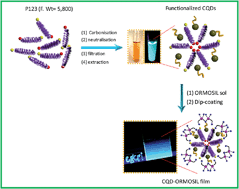Carbon nanodot–ORMOSIL fluorescent paint and films†
Abstract
Controlled carbonisation of P123 block-co-polymer in ethanol yielded micelle-protected carbon nanodots (CNDs) at room temperature. A purified and concentrated CND solution (quantum yield 10%) was incorporated into the organically-modified SiO2 (ORMOSIL) sol for the fabrication of transparent fluorescent coatings of thickness ∼3 μm on glass. These films are scratch resistant with a surface hardness value of 8H. The sol can also be useful as a fluorescent ink/paint. The films retained the pristine photophysical properties of CNDs.

- This article is part of the themed collection: 2015 Journal of Materials Chemistry C Hot Papers

 Please wait while we load your content...
Please wait while we load your content...